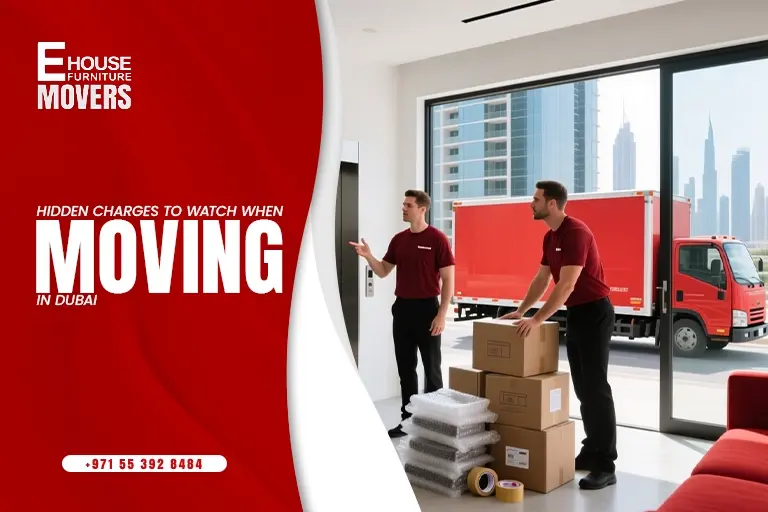The Dubai Statistics Center (2024) reports that more than 63% of Dubai residents live in apartments, and one-bedroom units (1BHK) are the most common among working professionals and small families. Planning a 1BHK relocation requires structured preparation. Estimation must cover box counts, crew allocation, service elevator scheduling, and building access. These elements govern time, sequence, and cost.
According to the International Association of Movers (IAM, 2023), a typical 1BHK relocation in Dubai involves 25–35 boxes, 2–3 professional movers, and a 4–6 hour completion window. Variations occur due to building design, service elevator capacity, loading bay rules, and inventory size. These variables determine the number of elevator trips, truck utilization, and the need for additional manpower.
This article presents a data-based, in-depth framework for planning a 1BHK apartment move in Dubai. Each section references recognized standards and industry sources, including IAM, FIDI Global Alliance, and Dubai Municipality guidance. Tables and benchmarks are included to support capacity planning, time projections, and risk control.
Table of Contents
ToggleInventory and Space Metrics
The Dubai Statistics Center (2024) places most 1BHK apartments in the 650–900 sq. ft. range. This range influences total inventory, required cartons, and truck volume. Typical occupancy is two persons. Occupancy affects textiles, kitchen density, and electronics count.
Item Count and Distribution
According to IAM (2023) and FIDI (2023):
- Furniture: 25–30 items per 1BHK.
Includes bed frame, mattress, wardrobe, sofa set, dining table, coffee table, consoles, side tables, study desk, and chairs. Bulky units dominate cubic footage and determine truck stacking strategy. - Major appliances: 4–6 units.
Commonly, a refrigerator, a washing machine, a microwave, a television, and, where present, a dishwasher or a tumble dryer. Appliance weight and dimensions influence dolly use and elevator cycles. - Average shipment weight: 1,500–2,000 kg per household.
This estimate aggregates community relocation data and supports lift capacity checks and floor protection planning.
Space Utilization Impact
- Bedroom: 35–40% of household volume. Includes bed, wardrobe, dressers, and personal storage.
- Living room: 30–35%. Includes sofa set, TV unit, coffee tables, and display items.
- Kitchen: 20–25%. Includes utensils, pantry goods, cookware, and small appliances.
- Miscellaneous/Storage: 5–10%. Includes décor, books, footwear, and seasonal items.
These proportions align with the FIDI Household Goods Volume Study (2023) and establish baseline expectations for box counts and truck capacity. They also inform the packing order and staging zones within the apartment.
Detailed Box Count Breakdown
Accurate box counts drive capacity planning, crew scheduling, and service elevator reservations. Room function and item density determine carton sizes and the sequence of packing.
Total Box Requirement
A typical 1BHK requires 25–35 boxes. This range covers kitchen items, clothing, books, electronics, fragile items, and décor. Over-packing beyond 15% of the range can increase cost by 10–12% or force a second trip. Declaring out-of-gauge items at survey time prevents last-minute adjustments.
Box Count by Category
| Category | Average Box Count | Share of Total Volume (%) | Data Source |
| Clothing & Bedding | 10–12 | 35% | FIDI 2023 |
| Kitchenware & Pantry | 5–6 | 25% | IAM 2023 |
| Books & Documents | 3–4 | 10% | FIDI 2023 |
| Décor & Electronics | 4–5 | 20% | IAM 2023 |
| Fragile Items | 2–3 | 10% | FIDI 2023 |
Notes: clothing boxes benefit from wardrobe cartons where available; kitchen boxes require extra padding; fragile cartons need double-wall or dish-pack specifications.
Packing Recommendations
- Small boxes (1.5 cu. ft.) should not exceed 15–18 kg. Limits reduce injury risk and protect seams.
- Medium boxes (3 cu. ft.) suit clothes, linens, and light household goods.
- Large boxes (5 cu. ft.) should be used sparingly to avoid crushing and to maintain stack integrity.
- Cushion with bubble wrap or kraft paper for glassware; fill voids to prevent shift.
- Use uniform labels showing room and contents. Position labels on at least two sides for quick identification near elevators.
Correct carton selection and uniform labeling accelerate staging, reduce handling time, and support efficient elevator cycles.
Crew Size and Vehicle Allocation
Crew allocation and truck selection determine throughput. Benchmarks follow IAM (2023) and the Global Household Goods Relocation Survey (2023).
Optimal Crew Size
- Minimum requirement: 2 movers for basic packing and lifting.
- Recommended setup: 3 movers + 1 supervisor/driver for coordination and compliance.
- Efficiency data: A three-person crew completes packing and loading 20–30% faster than a two-person team.
- Additional mover effect: Each extra mover can reduce total duration by 30–45 minutes, where elevator access and staging are optimized.
Vehicle Capacity
- Truck size: 3–4 ton vehicle with 15–18 m³ loading capacity.
- Trip requirement: One trip is typically sufficient for 25–35 cartons plus standard furniture.
- Utilization rate: Target 85–90% volume utilization to prevent cargo shift and to preserve aisle space for load checks.
Labor Productivity Benchmarks
- One mover processes 10–12 boxes per hour under standard conditions.
- Dismantling large items (bed, dining table) adds 15–20 minutes per unit.
- Average team output: 35–40 boxes packed, loaded, transported, and staged within 4–6 hours, assuming normal traffic and elevator availability.
Correct crew-to-volume matching avoids idle time, shortens elevator queues, and limits double-handling.
Time Allocation and Scheduling
Scheduling guards against downtime and aligns building rules with operational steps. Benchmarks follow FIDI (2023) and Dubai Municipality Building Operations Guidelines (2023).
4.1 Average Time Per Task
| Task | Average Duration | Data Source |
| Pre-Move Survey | 15–20 minutes | IAM 2023 |
| Packing & Labeling | 2–3 hours | FIDI 2023 |
| Elevator Loading | 1–1.5 hours | Dubai Municipality |
| Transport (Intra-City) | 45–60 minutes | RTA Dubai |
| Unloading & Reassembly | 30–45 minutes | IAM 2023 |
Total Duration: 4-6 hours, in case of ordinary conditions of traffic and the availability of elevators.
Scheduling Considerations
- Elevator booking: Secure 24–48 hours in advance. Confirm slot, floor protection rules, and capacity.
- Preferred move window: 09:00–12:00 to avoid congestion and minimize heat.
- Peak-hour impact: 17:00–19:00 may add 20–30% to transport time on Sheikh Zayed Road and Al Khail Road (RTA Dubai Traffic Report, 2023).
- Buffering: Hold a 30–45 minute contingency for access checks, loading bay queues, and lift resets.
Sequencing for Efficiency
- Pack the kitchen and bedroom first. Stage sealed cartons near the entrance.
- Prioritize fragile cartons for elevator space with minimal stacking pressure.
- Load large furniture last to allow quick unloading and immediate reassembly at the destination.
- Keep inventory sheets visible. Tick off counts at the doorway and again at the truck.
This sequencing aligns manpower, elevator slots, and C with building constraints.
Elevator and Loading Bay Logistics
Building access protocols directly shapes overall duration. Requirements follow Dubai Municipality Building Regulations (2023) and IAM Access Control Guidelines (2023).
Elevator Trip Data
- Trips required: 8–12 per 1BHK move.
- Average elevator wait: 5–10 minutes per trip.
- Cycle time: 6–8 minutes including loading and unloading.
- Weight limit: 800–1,000 kg per trip in most residential towers.
Reservation Requirements
- Advance booking: 24–48 hours before move date.
- Time blocks: Typically 2–3 hour elevator windows per relocation.
- Approval: Security clearance and booking confirmation are mandatory. Floor and wall protection may be required.
Loading Bay Coordination
- Truck parking window: Commonly 1–2 hours, subject to building policy.
- Access limitations: Certain communities route large trucks to specific gates.
- Compliance penalty: Unauthorized loading zone use may incur AED 500–1,000 fines.
Risk Mitigation
- Lack of reservations can add 30–60 minutes or force rescheduling.
- Communicate truck arrival 30 minutes before slot time to onsite security.
- Prepare floor protection and corner guards to prevent hold-ups.
First-Night Box Protocol
The FIDI Mobility Research Report (2022) and IAM Household Relocation Guidelines (2023) endorse the first-night box as an essential control. It ensures immediate access to essentials without full unpacking.
Purpose
- Reduces first-night unpacking time by 40–50%.
- Prevents misplacement of critical items.
- Supports normal routines within hours of arrival.
Recommended Contents
| Category | Examples | Data Source |
| Bedding | Bedsheets, pillow covers, blanket | FIDI 2022 |
| Personal Care | Toiletries, medication, towel | IAM 2023 |
| Electronics | Phone chargers, laptop chargers | IAM 2023 |
| Food & Drink | Bottled water, snacks, disposable cutlery | FIDI 2022 |
| Clothing | One change of clothes, nightwear | IAM 2023 |
| Miscellaneous | Basic cleaning supplies, flashlight | FIDI 2022 |
Packing Method
- Use a medium box (3 cu. ft.) or compact suitcase.
- Mark “FIRST-NIGHT BOX” on multiple sides.
- Load last, so it is unloaded first.
Impact on Moving Day
Households that prepare this box focus on essential setup—bed assembly, curtains, and basic kitchen use—without sifting through multiple cartons on day one.
Risk Factors and Delays
The IAM Risk and Operations Report (2023) identifies common delays. Managing these variables protects the timeline and the budget.
Common Delay Causes
| Risk Factor | Average Delay Impact | Data Source |
| Unbooked Service Elevator | +30–60 minutes | Dubai Municipality 2023 |
| Traffic Congestion (Peak Hours) | +20–40 minutes | RTA Dubai 2023 |
| Undeclared Extra Volume | +10–15% more time and cost | IAM 2023 |
| Restricted Moving Hours | Rescheduling or partial move | Community Guidelines 2023 |
| Insufficient Crew Allocation | +45–60 minutes extra work | FIDI 2023 |
Environmental and Seasonal Factors
- Summer heat (≥40 °C): Productivity reduction 10–15% (Occupational Safety Data UAE 2023).
- Rain events: Safety procedures can add 20–30 minutes to loading or transport
Mitigation Strategies
- Confirm elevator and loading bay slots 48 hours in advance.
- Select weekday mornings (09:00–12:00) to reduce congestion.
- Declare full inventory during the pre-move survey.
- Allocate 3 movers for standard 1BHK moves to balance speed and handling safety.
Effective risk management can reduce overall variance by up to 25%.
Cost Framework
Costs derive from manpower hours, truck allocation, and building access. Benchmarks reflect the Dubai Relocation Industry Survey (2024) and IAM Cost Analysis (2023).
Manpower Costs
| Resource | Average Rate (AED) | Data Source |
| Mover (per hour) | 50–70 | Industry Survey 2024 |
| Supervisor/Driver | 60–80 | IAM 2023 |
| Extra Manpower | +15–20% surcharge per mover | FIDI 2023 |
A standard three-person crew working 4–6 hours contributes 50–60% of the total relocation cost.
Vehicle and Equipment Charges
- Medium truck (3–4 ton): AED 250–350 per trip (Dubai transport operator data, 2023).
- Packing materials: AED 5–10 per carton (industry average).
- Special handling: 10–20% surcharge for pianos, safes, or oversized items.
Total Cost Range
| Cost Element | Estimated Range (AED) | Data Source |
| Total Manpower | 600–900 | Industry Survey 2024 |
| Truck & Fuel | 250–350 | Dubai Transport Data |
| Packing Supplies | 50–100 | FIDI 2023 |
| Total Estimated | 900–1,300 | Industry Composite Data |
Cost Variation Factors
- Building permits or access fees: +5–10%.
- Extra volume beyond plan (>15%): +10–15%.
- Peak season (June–September): +10–20%.
- Multiple stops or storage detours: Additional time and fuel charges.
Accurate inventory disclosure and confirmed access reduce unexpected surcharges.
Moving Day Checklist
Follow a structured checklist to improve control and reduce errors. Guidance reflects IAM Operations (2023) and FIDI Best Practices (2023).
Pre-Move Confirmation
- Confirm service elevator and loading bay reservations 24–48 hours in advance.
- Verify truck parking permits and entry gate rules with building security.
- Reconfirm crew arrival time and contact numbers for the moving day.
Preparation Before Crew Arrival
- Label each box with the room and contents.
- Separate fragile items and mark FRAGILE on at least two sides.
- Keep passports, documents, jewelry, and cash in personal custody.
- Stage boxes near the entrance for fewer elevator cycles.
- Set aside the first-night box for last-on, first-off handling.
During the Move
- Track elevator cycles and keep corridors clear.
- Cross-check box counts against the inventory list before truck loading.
- Photograph high-value or fragile items to document condition.
- Ensure floor and wall protections are intact to avoid delays.
Post-Move Actions
- Supervise room-wise placement at the destination.
- Verify furniture reassembly and test appliances.
- Confirm carton count on delivery.
- Sign completion only after a final walkthrough.
A consistent checklist can improve process efficiency by 15–20%.
Conclusion
Relocating a 1BHK apartment in Dubai follows a predictable framework when supported by accurate data and confirmed access. The Dubai Statistics Center (2024), FIDI (2023), and IAM (2023) indicate that a standard move typically involves 25–35 cartons, a 2–3 person crew, and a 3–4 ton truck with 15–18 m³ capacity. The combined timeline averages 4–6 hours, covering packing, elevator loading, transport, and reassembly. Typical costs fall in the AED 900–1,300 range, with seasonal and access-related adjustments.
Effective elevator booking, complete inventory disclosure, and a prepared first-night box reduce delays and improve first-day comfort. Structured risk management—crew sizing, morning scheduling, and clear staging—can cut time or cost overruns by up to 25%. The data and procedures summarized here provide a reliable reference for planning 1BHK relocations in Dubai within building regulations and operational constraints.




